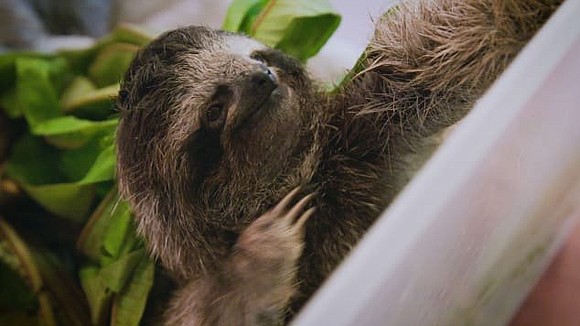Saving sloths in Costa Rica
CNN/Stylemagazine.com Newswire | 4/19/2019, 2:07 p.m.
Text by Lilit Marcus; Video by Deborah Brunswick, CNN
(CNN) -- It's pretty surprising to see a 27-year-old jump into her mother's arms and insist on being held like a baby.
At The Sloth Sanctuary outside of Cahuita, Costa Rica, though, such a sight is ordinary. Particularly when the 27-year-old is a sloth named Buttercup and the mother in question is a human.
In the more than a quarter century since, what began as one couple (Judy Avey-Arroyo and her late husband, Luis Arroyo) taking in an injured animal has turned into a combination animal rescue, hospital, research center and tourist attraction.
Avey-Arroyo and her husband met while both were working in Alaska. A Costa Rican by birth, Arroyo bought some land in his native country, on the wilder Atlantic Ocean coast, thinking it could be good for a vacation spot or maybe home to a birdwatching travel business.
Instead, it became a home.
And when a neighbor told them she'd found a baby sloth without its mother, the Arroyos took her in without question. Though they didn't know how to raise a sloth, they observed the ones who lived in the wild nearby and did the same things for Buttercup.
For example, they noticed which leaves and plants mother sloths in the wild fed their babies and gave the same ones to her. They built an enclosure for Buttercup to make sure she'd have something to climb, just like she would do on a tree in the jungle.
What began as the love of a man turned into the love of a country and, moreover, dozens of animals. Currently the sanctuary cares for 214 sloths, from babies to adults. Some can be released into the wild, while others have physical needs like a missing limb that require long-term care.
"I just love sloths," Avey-Arroyo says simply. "They're so peaceful, they're so generous, they're so gentle."
First things first: There are two animals we know as sloths.
The bradypus is the one commonly known as the three-toed sloth, with the distinctive brown "mask" marking on their face. The choloepus, or two-toed sloth, is a more consistent brown or tan color all over.
While the word for sloth is synonyous with laziness in many languages, Avey-Arroyo emphasizes that sloths aren't lazy so much as efficient -- they digest food very slowly and only need to come down from their tree perch once a week.
These days, sloths are having a pop culture moment. Actress Kristen Bell's obsession with sloths turned into a viral "Ellen Show" segment in 2012, and a (bradypus) sloth emoji was added to unicode in 2019 following popular demand.
Etsy is full of crafters capitalizing on all things sloth, from sloth jewelry and coffee mugs to "Live slow, die whenever" T-shirts.
But for Avey-Arroyo, sloths are anything but a trend -- they're her life's work.
However, the sanctuary isn't without its critics. In 2016, animal-centric website The Dodo published allegations from a former employee who claimed that Avey-Arroyo and her staff were keeping the sloths in dangerous conditions.
The ex-staffer, a Chilean vet named Dr. Camila Dunner, claimed that mismanagement at the sanctuary had resulted in the deaths of many animals.
Some also criticize The Sloth Sanctuary for turning the animals into zoo attractions.
For Avey-Arroyo, getting people interested in a misunderstood animal is still the foundation of what she does.
We want people to know, "how adorable they are. How amazing they are. How important they are to the scheme of things. To a healthy rainforest.
She adds: "My husband used to say all the time, 'My wish, my hope, my dream is to lift the sloths out of the darkness where they been for millennia and let people know them and appreciate them and love them.' And it's happening. We lost him seven years ago, but it's happening."




